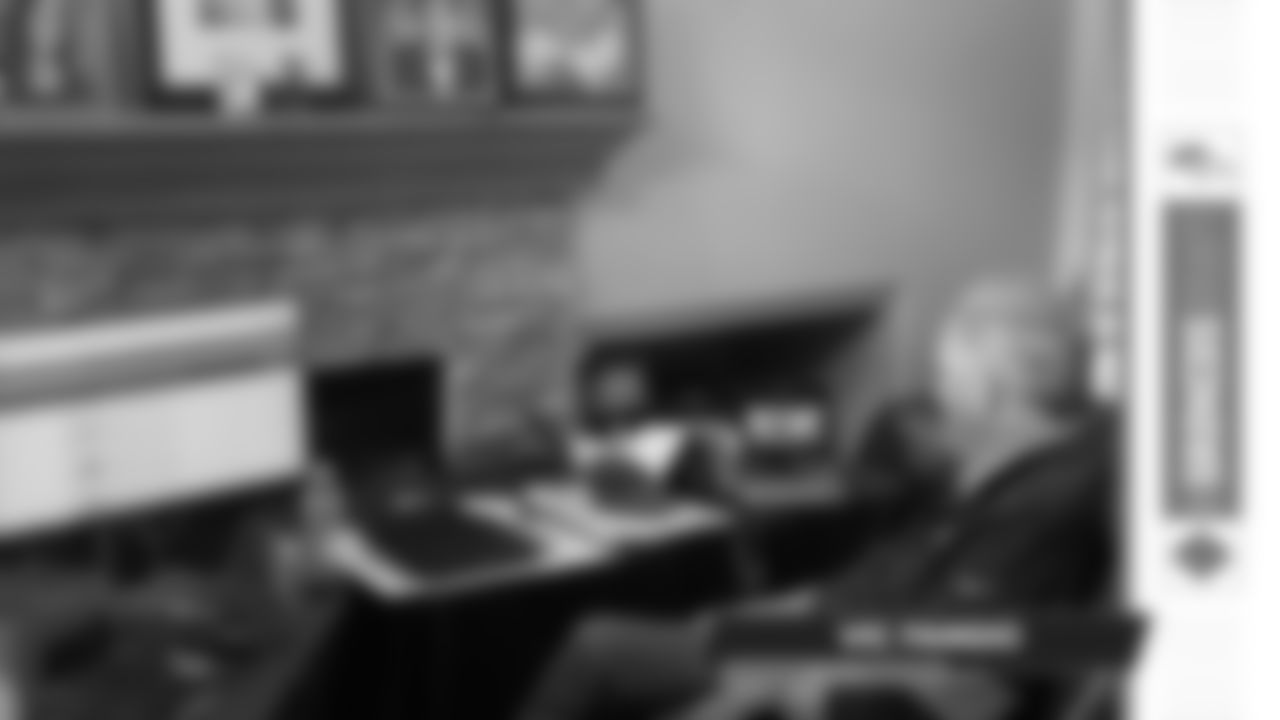ENGLEWOOD, Colo. — They had three days.
The impact of the novel coronavirus pandemic had begun to take shape in America, and the Broncos would not be exempt from the wave of shutdowns to come. It was just a matter of when, and on this Friday the 13th, staff members from the video operations department found themselves to be particularly lucky.
Come Monday, access to the team's facility would be closed off, with few exceptions. About a week later, the NFL would mandate the closure of all club facilities.
That wouldn't matter, though. Over that three-day span from March 13-15, the video staff would gather everything they needed, and in the coming weeks, they and their colleagues in the team's information technology and football information systems departments would prepare the infrastructure to ensure a successful, if stressful, 2020 NFL Draft.
'WE WERE JUST MAKING IT WORK'
COVID-19 would come to completely upend daily life, but the NFL largely stuck to its schedule. Free agency and the draft would not be postponed.
All the work could technically be done remotely. General managers, other front-office personnel and coaches could prepare for free agency and the draft in the comfort of their homes without completely requiring them to move mountains to do so. The main difficulty would be communication, but in the era of high-speed internet, was that really that big an obstacle?
The biggest challenge, naturally, would be the draft. A lot of work had already been done, but there was still more than a month before the draft began on April 23. That meant coaches and personnel executives would need the technological infrastructure to evaluate prospects and the means with which to work with their colleagues, both in the leadup to the draft and during the draft's three days.
The situation may have been taxing, but the timing was nothing short of fortuitous.
For one thing, the software that runs the virtual draft boards was already in place and has been for about five years.
"[Director of Football Information Systems] Tony [Lazzaro] and [Senior Applications Developer] Karl [Schreiner]'s system was already on a digital format, and we were looking to upgrade the war room soon, within the next year or two, and going all digital for that, so their system on the back end was kind of ready to go," Senior Vice President of IT Russ Trainor said. "… The timing was perfect from that perspective."
Instead, the focus centered on procuring the necessary hardware.
During the three days before the facility closure, Video Director Steve Boxer and his team rushed out to Micro Center, an electronics store in Denver.
"They thought we were ridiculous, but I think we bought 21 hard drives and cleaned them out," Boxer said. "Completely cleaned them out."
President of Football Operations/General Manager John Elway, Director of Player Personnel Matt Russell and Head Coach Vic Fangio needed to have access to footage of every prospect. They each got 10-terabyte hard drives, while position coaches and coordinators got ones about half the size.
In addition to the local storage, they would need extra monitors so that everyone could see everything they needed during the draft — internal scouting boards, draft results in real time, video conference calls with each other and more. Elway and Fangio, just on their own, needed seven or so monitors apiece.
In some ways, the Broncos were lucky. The spring is already usually when they process new budgets and upgrade technology, so they did have more screens than usual. Still, it wasn't enough. They had to find another solution, and fast.
Take a look inside the Broncos' 2020 NFL Draft setups in the homes of President of Football Operations/General Manager John Elway, Head Coach Vic Fangio and more.

A view of President of Football Operations/General Manager John Elway in his home setup for the 2020 NFL Draft.

A view of Head Coach Vic Fangio in his home setup for the 2020 NFL Draft.

A view of Director of Player Personnel Matt Russell in his home setup for the 2020 NFL Draft.

A view of Vice President of Football Administration Rich Hurtado in his home setup for the 2020 NFL Draft.

A view of Director of College Scouting Brian Stark in his home setup for the 2020 NFL Draft.

A view of Director of Pro Personnel A.J. Durso in his home setup for the 2020 NFL Draft.

A view of Director of Team Administration Mark Thewes in his home setup for the 2020 NFL Draft.

A view of Director of Sports Medicine Steve Antonopulos in his home setup for the 2020 NFL Draft.
"I think we had about 10 new monitors, but we did need more than that," Trainor said. "So we ended up stealing some monitors, pilfering them from some folks' desks. I took both of [Senior IT Engineer] Nick [Burris]'s monitors on my team. I took his monitors, took one of [Senior IT Engineer] Gil [Bencomo]'s. We were just making it work."
Then it was a matter of making sure everyone's internet would stand up to the demand required.
"Going into it, my biggest concern — security was an issue and some other things — but my biggest concern was home internet usage," Trainor said. "The home internet, it's not a business-class internet."
The goal was get everyone up to gigabit speed, which is up to 40 times faster than normal broadband internet. New plans, new routers, new modems — whatever it took. Everyone ended up getting some manner of upgrade, regardless of their internet service provider.
Trainor also set up a backup plan that included generators for electricity and cellular data mobile hotspots from Verizon.
All of it could not have been cheap, but the alternatives would have meant a higher chance of failure. That would be unacceptable.
"Really, to me, I think the way we are set up as an organization in a first-class way with [President and CEO] Joe [Ellis] and John's leadership has prepared us for this type of situation all along," said Director of Team Administration Mark Thewes. "The quality people we already have and all of the technology and infrastructure investments we have made in recent years really paid off and made it a really satisfying experience to witness."
Everything seemed to be falling into place as the draft approached.
On Monday, as the team continued to test their new system by conducting mock drafts, Fangio started making meatballs.
Trainor, stationed at Fangio's house for the week of the draft, noticed that he had a lot of ingredients, certainly more than he expected for one or two people. Fangio told him he makes four dozen at a time, and then he suggested, "Maybe we can try them later in the week."

FROM A DAY 1 SCARE TO SMOOTH SAILING
About 15 minutes before the NFL Draft broadcast began, the Vic Fangio broadcast ended.
"We were on a Zoom session," Boxer recalled, "and Vic's [screen] went black."
Luckily, the Broncos had stationed a support staffer to be available for everyone. Lazzaro was at Elway's house; Boxer covered Thewes and Director of Pro Personnel A.J. Durso, each of whom lived near him; and Trainor was on-site for the head coach.
Fangio had been encountering some slow internet speeds earlier in the afternoon, and Trainor called Comcast for some urgent on-site support. The minutes ticked away before they diagnosed a couple of poor-performing connectors, and at around 5:45 p.m., they brought down the internet.
"That was not the prime time, but his internet was too unsteady not to do it going into the draft," Trainor said. "So I made the call to get it fixed. And we got him up literally, it was 5:59 was when he came back alive, when his modem came back alive and everything started working. … I didn't want Coach not to be on those leadup conference calls with John and [Director of College Scouting] Brian [Stark] and Mark and A.J. and everybody else on those calls."
It was a bit stressful as time got tight, and it would require more maintenance on Friday morning, but Trainor truly earned the rare honor of trying Fangio's meatball recipe.
Other than those hiccups, things went pretty smoothly throughout the draft.
As personnel and coaching staff members prepared to decide on their selection, Thewes provided "situational recognition." When necessary, he put trade offers, medical reports from Director of Sports Medicine Steve "Greek" Antonopulos, scouting reports and background information on everyone's screen for them to review. He also kept an eye on league rules, reporting and compliance.
As the decisions were made, Thewes then had the important task of calling the newest Broncos to deliver the exciting news, transfer them to Elway and Fangio and then tell them the next steps as they prepare to begin their NFL careers.
Lazzaro had a particularly tough logistical balancing act, as he had to submit each of the picks (no typos allowed — he checked his spelling of Albert Okwuegbunam's name five times before entering the pick in Round 4), ensure Elway was able to field the calls transferred from Thewes and then record the calls on video. As the time shrank between each pick, that became more and more difficult. Eventually, Lazzaro recruited help from Elway's family to record the calls for the entirety of the third day of the draft.
"The time we're actually on the clock is chaotic, as it would be [normally]," Lazzaro said. "We'd wait to get them on [the phone with] the player, once we decided on a player. Mark would make the call to get the player on the phone initially and we wanted to make sure we got ahold of him and make contact with the player before we actually submitted the pick. Once we got that initial call in, I would submit the picks into the league. John would tell me who we wanted, so I'd submit that pick and try to answer the phone as it was coming in to him, so that John could talk to the pick and transfer the pick from John to Vic — and then in the meantime of that process, also try to record the phone calls and stuff for [digital media]."
It would be a very eventful three days for the team, of course, but the fact that it was largely uneventful from a technological standpoint proved the value of the Broncos' preparations.
"Because of the preparation and planning we did, I don't think it changed that much to be honest," Thewes said. "I would much rather be together in a room with everyone and feel the energy and teamwork that goes into the whole process — that part was missing just a little. Normally there is a bigger sense of camaraderie and celebration after a pick is turned in, but overall it was largely the same operationally. … This year I missed having the scouts in town for the draft since they put so much effort into the process throughout the entire year and are so vital to the results."
That said, it certainly made for a more memorable draft than usual.
"It was definitely a surreal experience," Lazzaro said. "I think this was my 22nd draft, and the rest of them kind of over the years start blending together for me. This is one I definitely won't forget. It was definitely a unique experience — hopefully something we don't have to replicate too many times. But I thought it was a real opportunity for us, to be honest. I felt really good technologically [with] where we were at, so it was a good opportunity to put a lot of that to the test and see it in action."

THE NEW NORMAL
Once the draft ended, the personnel and coaching staffs kept working, beginning with the process to sign college free agents who went undrafted.
There was room for seven additional prospects. This process is always a little hectic because it's basically a free-for-all among teams on the third day of the draft as the final round winds down, but this year presented unusual circumstances since decision-makers couldn't collaborate in person.
"The post-draft process with college free agents was a little different this year," Thewes said. "Matt, A.J. and [Vice President of Football Administration] Rich [Hurtado] headed that charge and it went really well. … The post-draft portion is the part that is most different this year for everyone, trying to coordinate remotely with 17 new rookies on things like contracts, human resources, getting them their iPad and how to use the video software, getting their sizes and some Broncos gear from [Equipment Manager Chris] 'Flip' [Valenti], getting time with 'Greek' [or Head Athletic Trainer] Vince [Garcia] to review medical or rehab, introducing them to [Director of Team Nutrition] Bryan Snyder and his nutrition resources, and [Director of Player Development] Ray Jackson has a whole rookie program for them to go through in conjunction with the NFL.
"This year this all has to take place via Zoom or phones calls, texts, etc. Normally we can accomplish most of the administrative pieces within their first couple days at rookie minicamp, and then hand them over to the coaches for football. Lots more coordination is required this year, and the NFL has some specific one-time rules we are following as we go."
Then the team continued its virtual work, now moving on from the draft and into the three-week voluntary virtual offseason program that began Monday. Coaches are able to hold Zoom meetings with veteran players to go over their playbooks or non-football topics and to conduct a strength and conditioning program.
As unusual as it may have felt initially, this setup has gradually become more and more comfortable. The ability for a roster of 90 players and dozens of coaches and other staffers to congregate together still seems far away, so it's been a necessary progression.
"For the most part, these guys are knocking it out of the park right now," said Boxer, who has been helping monitor the virtual meetings. "… It's still weird, even though it's kind of becoming a normal thing to me now, which is also kind of weird, but they're getting there."















